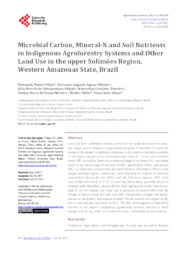Microbial carbon, mineral-N and soil nutrients in indigenous agroforestry systems and other land use in the upper Solimões Region, Western Amazonas State, Brazil.
Microbial carbon, mineral-N and soil nutrients in indigenous agroforestry systems and other land use in the upper Solimões Region, Western Amazonas State, Brazil.
Author(s): VILLANI, F. T.; RIBEIRO, G. A. A.; VILLANI, E. M. de A.; TEIXEIRA, W. G.; MOREIRA, F. M. de S.; MILLER, R.; ALFAIA, S. S.
Summary: Slash and burn cultivation systems carried out by many farmers in the Amazon region lead to changes in biogeochemical cycles of nutrients. To assess the extent of the impact of shifting cultivation on the soil in a floodplain portion of this region, samples of an Inceptisol surface layer (0 - 5 cm) under primary forest (FP), secondary forest at an advanced stage of recovery (FS), secondary forest at an initial stage of recovery (CAP), agroforestry (SAF), plantations (RÇ) in indigenous communities and small farmers, and pasture (PAS) in the Upper Solimões region, Amazonas, were subjected to analysis of chemical composition during the wet (May) and dry (October) seasons, 2007. Soils were fertile with levels of P, K, Ca and Mg above those generally found in Amazon soils. Microbial content did not vary significantly in the systems studied in the wet season, but there was a reduction of around 60% with the change of season, except for soils with SAF. Ammonium nitrogen was predominant in all systems and seasons studied. Nitrate content was higher in RÇ soil, in two seasons, and lower in PAS. The type of management adopted by farmers in the regions indigenous agroforestry systems resulted in small changes in P, K, Mg, MBC and mineral-N levels, independent of soil moisture.
Publication year: 2017
Types of publication: Journal article
Unit: Embrapa Soils
Observation
Some of Embrapa's publications are published as ePub files. To read them, use or download one of the following free software options to your computer or mobile device. Android: Google Play Books; IOS: iBooks; Windows and Linux: Calibre.
Access other publications
Access the Agricultural Research Database (BDPA) to consult Embrapa's full library collection and records.
Visit Embrapa Bookstore to purchase books and other publications sold by Embrapa.

